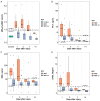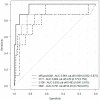Comprehensive Assessment of Mid-Regional Proadrenomedullin, Procalcitonin, Neuron-Specific Enolase and Protein S100 for Predicting Pediatric Severe Trauma Outcomes
- PMID: 37626802
- PMCID: PMC10452732
- DOI: 10.3390/biomedicines11082306
Comprehensive Assessment of Mid-Regional Proadrenomedullin, Procalcitonin, Neuron-Specific Enolase and Protein S100 for Predicting Pediatric Severe Trauma Outcomes
Abstract
The development of multiple organ failure and septic complications increases the cumulative risk of mortality in children with severe injury. Clinically available biochemical markers have shown promise in assessing the severity and predicting the development of complications and outcomes in such cases. This study aimed to determine informative criteria for assessing the severity and outcome prediction of severe injury in children based on levels of mid-regional proadrenomedullin (MR-proADM) procalcitonin (PCT), neuron-specific enolase (NSE), and protein S100. Biomarker levels were measured in 52 children with severe injury (ISS ≥ 16) on the 1st, 3rd, 7th, and 14th days after admission to the ICU. The children were divided into groups based on their favorable (n = 44) or unfavorable (n = 8) outcomes according to the Severe Injury Outcome Scale, as well as their favorable (n = 35) or unfavorable (n = 15) outcomes according to the Glasgow Coma Outcome Scale (GOS). The study also evaluated the significance of biomarker levels in predicting septic complications (with SC (n = 16) and without SC (n = 36)) and diagnosing and stratifying multiple organ failure (with MOF (n = 8) and without MOF (n = 44)). A comprehensive assessment of MR-proADM and PCT provided the highest diagnostic and prognostic efficacy for early diagnosis, risk stratification of multiple organ failure, and outcome prediction in severe injury cases involving children. Additionally, the inclusion of the S100 protein in the study allowed for further assessment of brain damage in cases of traumatic brain injury (TBI), contributing to the overall prognostic model.
Keywords: MR-proADM; NSE; PCT; children; multiple organ failure; outcome prediction; polytrauma; protein S100; severe injury; traumatic brain injury.
Conflict of interest statement
The authors declare no conflict of interest.
Figures


Similar articles
-
Diagnostic and prognostic value of procalcitonin and mid-regional pro-adrenomedullin in septic paediatric patients.Eur J Pediatr. 2020 Jul;179(7):1089-1096. doi: 10.1007/s00431-020-03587-7. Epub 2020 Jan 23. Eur J Pediatr. 2020. PMID: 31974673
-
Prognostic Value of Serum Levels of S100 Calcium-Binding Protein B, Neuron-Specific Enolase, and Interleukin-6 in Pediatric Patients with Traumatic Brain Injury.World Neurosurg. 2018 Oct;118:e534-e542. doi: 10.1016/j.wneu.2018.06.234. Epub 2018 Jul 6. World Neurosurg. 2018. PMID: 30257306
-
Levels of S100 calcium binding protein B (S100B), neuron-specific enolase (NSE), and cyclophilin A (CypA) in the serum of patients with severe craniocerebral injury and multiple injuries combined with delirium transferred from the ICU and their prognostic value.Ann Palliat Med. 2021 Mar;10(3):3371-3378. doi: 10.21037/apm-21-424. Ann Palliat Med. 2021. PMID: 33849122
-
New role of biomarkers: mid-regional pro-adrenomedullin, the biomarker of organ failure.Ann Transl Med. 2016 Sep;4(17):329. doi: 10.21037/atm.2016.08.65. Ann Transl Med. 2016. PMID: 27713887 Free PMC article. Review.
-
Proadrenomedullin in Sepsis and Septic Shock: A Role in the Emergency Department.Medicina (Kaunas). 2021 Sep 1;57(9):920. doi: 10.3390/medicina57090920. Medicina (Kaunas). 2021. PMID: 34577843 Free PMC article. Review.
Cited by
-
Neuron-specific enolase: a potential biomarker in the prediction of pediatric head trauma outcomes: a systematic review and meta-analysis.Int J Emerg Med. 2025 Jul 1;18(1):113. doi: 10.1186/s12245-025-00932-1. Int J Emerg Med. 2025. PMID: 40597577 Free PMC article. Review.
References
-
- Timofeev V., Bondarenko A. Epidemiological aspects of polytrauma in children in major city. Polytrauma Russ. 2012;4:5–8.
-
- Andruszkow H., Fischer J., Sasse M., Brunnemer U., Andruszkow J.H.K., Gänsslen A., Hildebrand F., Frink M. Interleukin-6 as Inflammatory Marker Referring to Multiple Organ Dysfunction Syndrome in Severely Injured Children. Scand. J. Trauma Resusc. Emerg. Med. 2014;22:16. doi: 10.1186/1757-7241-22-16. - DOI - PMC - PubMed
-
- Calkins C.M., Bensard D.D., Moore E.E., McIntyre R.C., Silliman C.C., Biffl W., Harken A.H., Partrick D.A., Offner P.J. The Injured Child Is Resistant to Multiple Organ Failure: A Different Inflammatory Response? J. Trauma Inj. Infect. Crit. Care. 2002;53:1058–1063. doi: 10.1097/00005373-200212000-00005. - DOI - PubMed
LinkOut - more resources
Full Text Sources

